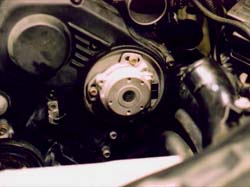


There has been a lot of discussion and interest in adjusting the timing of the TT to gain horsepower (I have not done this on a NA, but it could be done). First off, a disclaimer, Jim Wolf does not recommend adjusting the timing, if anything, he suggests setting it at 13 degrees (stock TT is 15 degrees + or - 2 degrees). However, there are other opinions out there about the safety and potential for horsepower. So, it is up to each individual to decide if this something they want to do. My suggestion is to do some research on your own.
NOTE: We've since found the '96 NAs are factory @ 10 degrees BTC, so make adjustments accordingly.
Tools:
10 mm socket wrench
screw driver
timing light with an inductive sensor
an accurate boost gauge
preferably time on a DynoJet Dynomometer to measure the results.
Realize the specific timing set from the factory varies from car to car. Case in point:
| My 93 TT Stage III | My brother's 93 TT Stage III | |
| Before adjusting the timing: | 301.4 hp and 340.6 lb/ft torque | 287.0 hp and 321.9 lb/ft of torque |
| After adjusting the timing: | 310.9 hp and 347.4 lb/ft torque | 310.1 hp and 342.1 lb/ft torque |
| Net gain: | 9.5 hp and 6.8 lb/ft torque | 23.1 hp and 20.2 lb/ft torque |
Make an initial run on the Dyno Jet for a baseline and check your boost level (don't want to be running too much - 15lbs max. for Stage III or too little). Check the stock timing with a timing light. If you don't have access to a timing light, you can still do this, but it is not as safe. If you don't have access to a Dyno Jet, then just proceed to the next step. To adjust the timing you are going to loosen the three 10 mm bolts on the crank angle sensor. This sensor is located on the front right of the engine (when facing the engine from the front of the car), behind the fan. It is about 3" in diameter, silver, and has a black connector attached to the right side.

Before loosening the bolts you need to scratch a mark into the metal of the crank angle sensor & engine, so you will know where the stock setting was. OK, you have loosened (NOT REMOVED) the three bolts. Now, using the plastic handle of a screw driver (or other such device) you are going to TAP on the left side of the crank angle sensor (Counter Clockwise) until you have moved the mark you previously made by a millimeter (mm), that's right, one millimeter. Make very small adjustments, then tighten the bolts back up some so that the crank angle sensor does not move. Make another Dyno Jet run and compare the results. Check the timing again with the timing light.
The non-technical way to proceed is to keep upping the timing by very small increments and rerunning on the Dyno Jet until you encounter safety boost (i.e. detonation). If you don't have access to a Dyno Jet, find access. If you still can't then you are really going to have go out and make some runs on the street. I DO NOT RECOMMEND THIS. You need some type of controlled environment! Detonation can be heard & stopped on the Dynojet before damage can occur. At this point, back the timing off some (tapping clockwise). Make another mark on the metal, this is your highest timing limit. I am personally running in between the stock setting and the highest setting that I could safely run.
The technical way to proceed is to just use the timing light to set the timing. I would not recommend going higher than 17 - 19 degrees. Make some runs on the Dyno Jet at various settings to document the changes.
That's it. Make sure you tighten everything up. If you live in a hot and/or humid area, you may encounter safety boost problems, if you made the marks on the crank angle sensor, you can always move it back to stock for a while until it gets cooler.
Russell 'Silky Smooth' Siebert
© Twin Turbo Zs of
Dallas - All Rights Reserved 1997